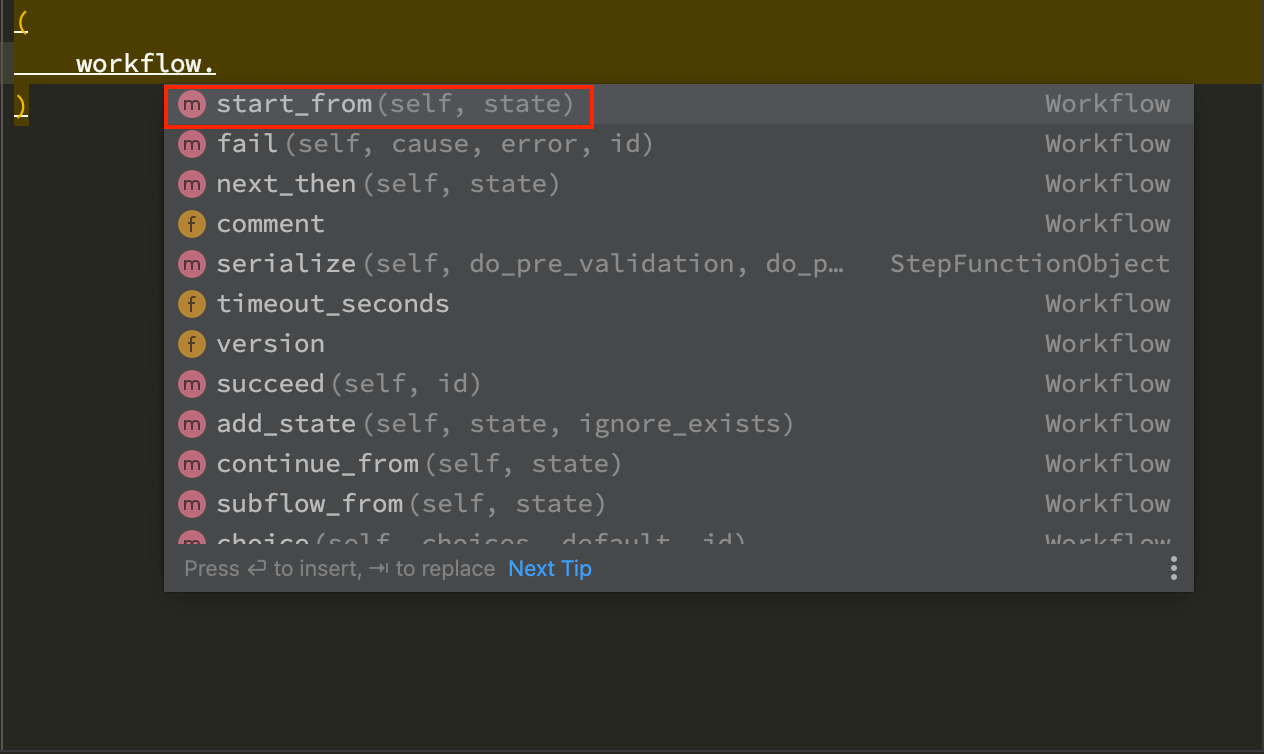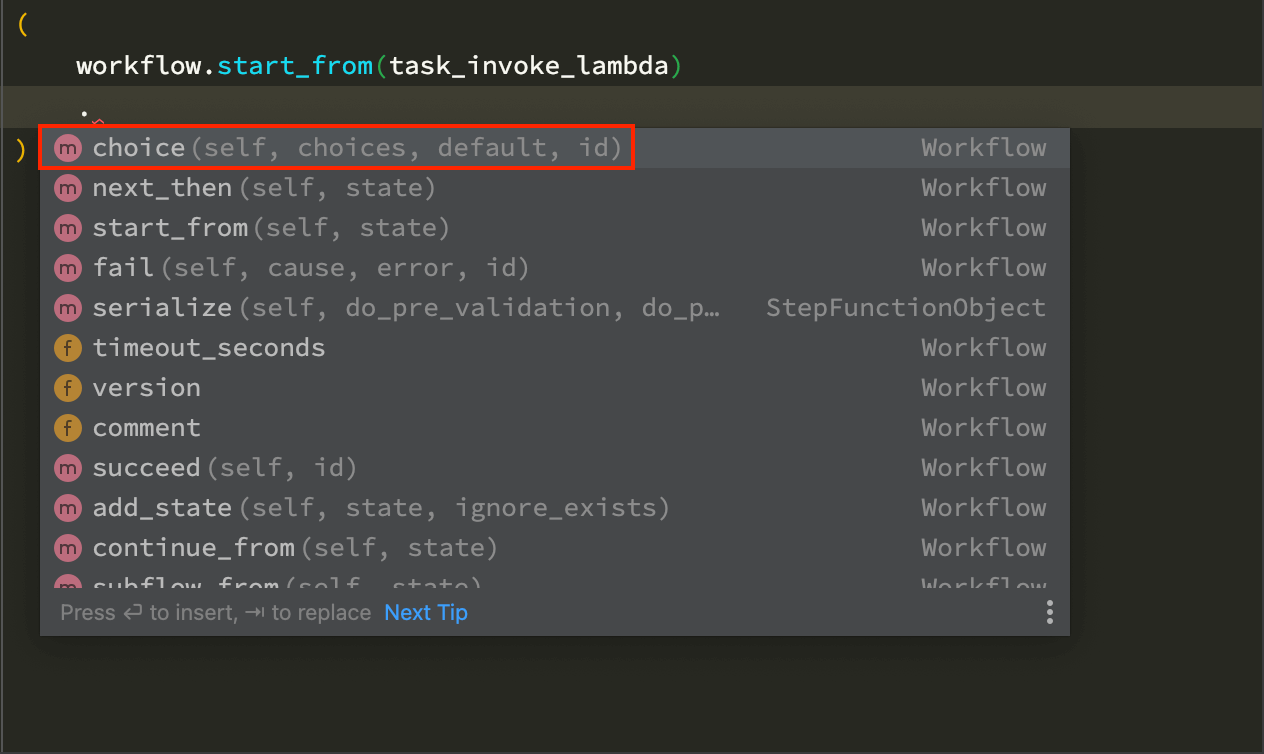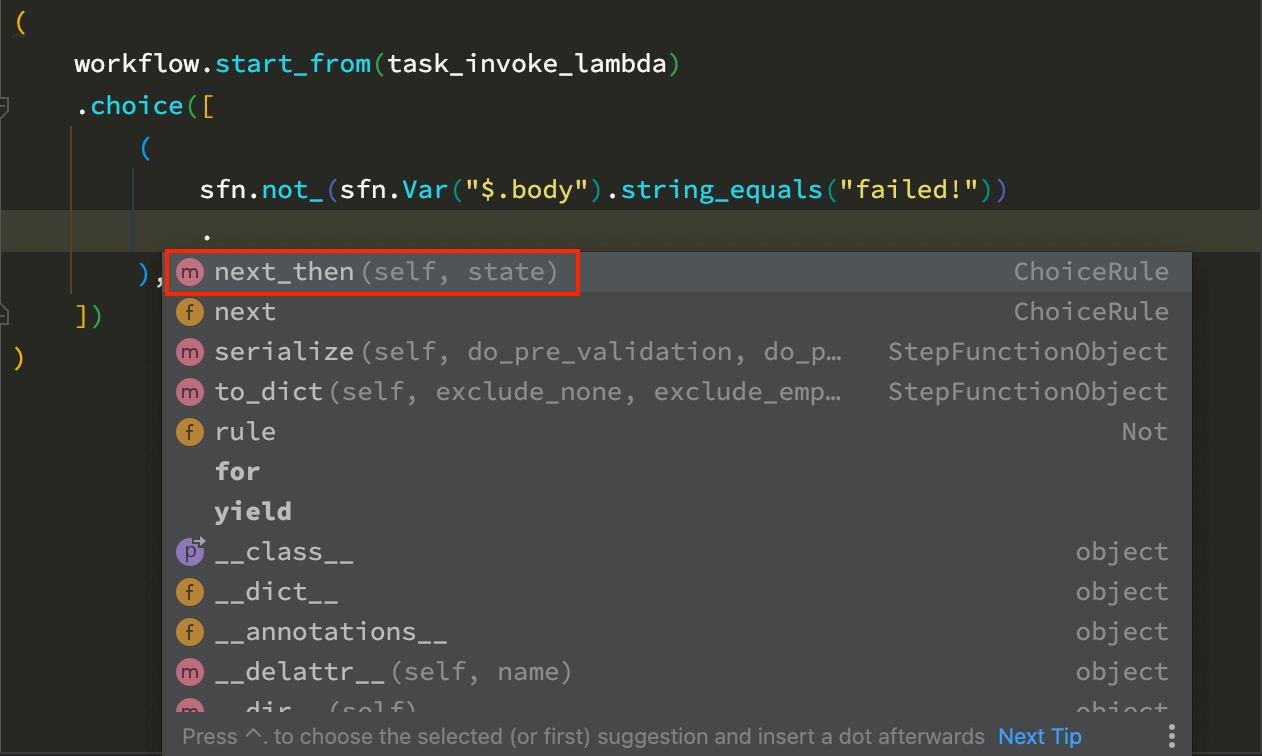Quick Start¶
In this tutorial, let’s learn how to use aws_stepfunction library to create / deploy / execute / delete an AWS StepFunction.
The test Lambda Function¶
First, let’s create a simple lambda function for testing. The logic is to json encode the input event and just return. This lambda function has 30 % chance to fail. The lambda execution won’t fail, however, it returns an 400 HTTP status code.
[4]:
# content of lambda_handler.py
import json
import random
def lambda_handler(event, context):
if random.randint(1, 100) <= 70:
return {
"statusCode": 200,
"body": json.dumps(event),
}
else:
return {
"statusCode": 400,
"body": "failed!"
}
Sample input output
[7]:
# succeed
lambda_handler({"message": "hello world"}, None)
[7]:
{'statusCode': 200, 'body': '{"message": "hello world"}'}
[17]:
# fail
lambda_handler({"message": "hello world"}, None)
[17]:
{'statusCode': 400, 'body': 'failed!'}
Create a Step Function¶
Now let’s learn the power of aws_stepfunction library.
[1]:
# ------------------------------------------------------------------------------
# Step 1. import, preparation
# ------------------------------------------------------------------------------\
# Import the "aws_stepfunction" library,
# all public API can be accessed from the "sfn" namespace
import aws_stepfunction as sfn
from boto_session_manager import BotoSesManager
from rich import print # for pretty print
# Create a boto3 session manager object
# the credential you are using should have STS.get_caller_identity permission
# it is for getting the AWS Account ID information
bsm = BotoSesManager(
profile_name="aws_data_lab_sanhe_us_east_1",
region_name="us-east-1",
)
# You could tell the task context about the aws_account_id and aws_region
# then you can only need to provide lambda function name without the full ARN.
sfn.task_context.aws_account_id = bsm.aws_account_id
sfn.task_context.aws_region = bsm.aws_region
# Declare a workflow object
workflow = sfn.Workflow(
comment="The power of aws_stepfunction library!", # put random comment here
)
print(workflow)
Workflow( id='Workflow-1a98433', comment='The power of aws_stepfunction library!', version=None, timeout_seconds=None, _start_at=None, _states=OrderedDict(), _started=False, _previous_state=None )
[2]:
# ------------------------------------------------------------------------------
# Step 2. Define some tasks and states
# ------------------------------------------------------------------------------
# There are some helper functions to create common task.
# These helper functions are just the equivalent of
# The widget in Step Function Visual Editor
# define a lambda function invoke task
task_invoke_lambda = sfn.actions.lambda_invoke(func_name="stepfunction_quick_start")
# define a succeed state
succeed = sfn.Succeed()
# define a fail state
fail = sfn.Fail()
print(task_invoke_lambda)
print(succeed)
print(fail)
Task( comment=None, next=None, end=None, input_path=None, output_path='$.Payload', parameters={ 'Payload.$': '$', 'FunctionName': 'arn:aws:lambda:us-east-1:669508176277:stepfunction_quick_start' }, result_selector={}, result_path=None, retry=[ Retry( error_equals=['Lambda.ServiceException', 'Lambda.AWSLambdaException', 'Lambda.SdkClientException'], interval_seconds=2, backoff_rate=2, max_attempts=3 ) ], catch=[], id='Task-1824cda', type='Task', resource='arn:aws:states:::lambda:invoke', timeout_seconds_path=None, timeout_seconds=None, heartbeat_seconds_path=None, heartbeat_seconds=None )
Succeed(comment=None, input_path=None, output_path=None, id='Succeed-4c067dd', type='Succeed')
Fail(comment=None, id='Fail-a6fa70c', type='Fail', cause=None, error=None)
[3]:
# ------------------------------------------------------------------------------
# Step 3. Orchestrate the Workflow
# ------------------------------------------------------------------------------
# We use this "Human-language alike", "Pythonic", "Objective Oriented"
# "Auto-complete empowered" code pattern to create a human-readable workflow
(
workflow.start(task_invoke_lambda)
.choice([
# choice 1, succeed case
( # define condition
sfn.not_(sfn.Var("$.body").string_equals("failed!"))
# define next action
.next_then(succeed)
),
# choice 2, fail case
(
# define condition
sfn.Var("$.body").string_equals("failed!")
# define next action
.next_then(fail)
),
])
)
print(workflow.serialize())
{ 'StartAt': 'Task-1824cda', 'Comment': 'The power of aws_stepfunction library!', 'States': { 'Task-1824cda': { 'Type': 'Task', 'Resource': 'arn:aws:states:::lambda:invoke', 'Next': 'Choice-by-Task-1824cda', 'Parameters': { 'Payload.$': '$', 'FunctionName': 'arn:aws:lambda:us-east-1:669508176277:stepfunction_quick_start' }, 'OutputPath': '$.Payload', 'Retry': [ { 'ErrorEquals': [ 'Lambda.ServiceException', 'Lambda.AWSLambdaException', 'Lambda.SdkClientException' ], 'IntervalSeconds': 2, 'BackoffRate': 2, 'MaxAttempts': 3 } ] }, 'Choice-by-Task-1824cda': { 'Type': 'Choice', 'Choices': [ {'Not': {'Variable': '$.body', 'StringEquals': 'failed!'}, 'Next': 'Succeed-4c067dd'}, {'Variable': '$.body', 'StringEquals': 'failed!', 'Next': 'Fail-a6fa70c'} ] }, 'Succeed-4c067dd': {'Type': 'Succeed'}, 'Fail-a6fa70c': {'Type': 'Fail'} } }
[4]:
# ------------------------------------------------------------------------------
# Step 4. Declare an instance of AWS State Machine for AWS console
# ------------------------------------------------------------------------------
# This is the metadata of the concrete AWS State Machine resource
state_machine = sfn.StateMachine(
name="stepfunction_quick_start",
workflow=workflow,
role_arn="arn:aws:iam::669508176277:role/state-machine-role",
)
print(state_machine.get_state_machine_arn(bsm))
print(state_machine.get_state_machine_console_url(bsm))
arn:aws:states:us-east-1:669508176277:stateMachine:stepfunction_quick_start
https://us-east-1.console.aws.amazon.com/states/home?region=us-east-1#/statemachines/view/arn:aws:states:us-east-1: 669508176277:stateMachine:stepfunction_quick_start
[5]:
# ------------------------------------------------------------------------------
# Step 5. Deploy / Execute / Delete State Machine
# ------------------------------------------------------------------------------
# deploy (create / update)
state_machine.deploy(bsm)
deploy state machine to 'arn:aws:states:us-east-1:669508176277:stateMachine:stepfunction_quick_start' ...
not exists, create state machine ...
done, preview at: https://us-east-1.console.aws.amazon.com/states/home?region=us-east-1#/visual-editor?stateMachineArn=arn:aws:states:us-east-1:669508176277:stateMachine:stepfunction_quick_start
[5]:
{'stateMachineArn': 'arn:aws:states:us-east-1:669508176277:stateMachine:stepfunction_quick_start',
'creationDate': datetime.datetime(2022, 8, 5, 19, 23, 49, 785000, tzinfo=tzlocal()),
'ResponseMetadata': {'RequestId': 'df4a6cf2-3448-4bb0-9e7d-c06a28622de2',
'HTTPStatusCode': 200,
'HTTPHeaders': {'x-amzn-requestid': 'df4a6cf2-3448-4bb0-9e7d-c06a28622de2',
'date': 'Fri, 05 Aug 2022 23:23:49 GMT',
'content-type': 'application/x-amz-json-1.0',
'content-length': '129'},
'RetryAttempts': 0},
'_deploy_action': 'create'}

[6]:
# execute state machine with custom payload
state_machine.execute(bsm, payload={"name": "alice"})
execute state machine 'arn:aws:states:us-east-1:669508176277:stateMachine:stepfunction_quick_start'
preview at: https://us-east-1.console.aws.amazon.com/states/home?region=us-east-1#/executions/details/arn:aws:states:us-east-1:669508176277:execution:stepfunction_quick_start:8f26d437-1806-498f-941a-447b390ccdac
[6]:
{'executionArn': 'arn:aws:states:us-east-1:669508176277:execution:stepfunction_quick_start:8f26d437-1806-498f-941a-447b390ccdac',
'startDate': datetime.datetime(2022, 8, 5, 19, 24, 14, 476000, tzinfo=tzlocal()),
'ResponseMetadata': {'RequestId': '14025e4c-5ac3-4e7b-87ae-2eff8dc7cd9b',
'HTTPStatusCode': 200,
'HTTPHeaders': {'x-amzn-requestid': '14025e4c-5ac3-4e7b-87ae-2eff8dc7cd9b',
'date': 'Fri, 05 Aug 2022 23:24:14 GMT',
'content-type': 'application/x-amz-json-1.0',
'content-length': '157'},
'RetryAttempts': 0}}

[7]:
# delete state machine
state_machine.delete(bsm)
delete state machine 'arn:aws:states:us-east-1:669508176277:stateMachine:stepfunction_quick_start'
done, exam at: https://us-east-1.console.aws.amazon.com/states/home?region=us-east-1#/statemachines/view/arn:aws:states:us-east-1:669508176277:stateMachine:stepfunction_quick_start
[7]:
{'ResponseMetadata': {'RequestId': '16346f8e-6341-4c1d-a174-f9107a0e5c27',
'HTTPStatusCode': 200,
'HTTPHeaders': {'x-amzn-requestid': '16346f8e-6341-4c1d-a174-f9107a0e5c27',
'date': 'Fri, 05 Aug 2022 23:25:53 GMT',
'content-type': 'application/x-amz-json-1.0',
'content-length': '2'},
'RetryAttempts': 0}}
Summary¶
The objective of aws_stepfunction library is to provide developer a “smooth”, “interruption free”, “enjoyable” development experience. The orchestration code itself is just like human-language, and tells the story without any comments.
In addition, the API and type hint are designed for static check and auto-complete. If you use any modern IDE / Code Editor like PyCharm, VSCode, Sublime, Eclipse, the learning curve should be minimal and the IDE will tell you all the syntax you need for coding.




[ ]: